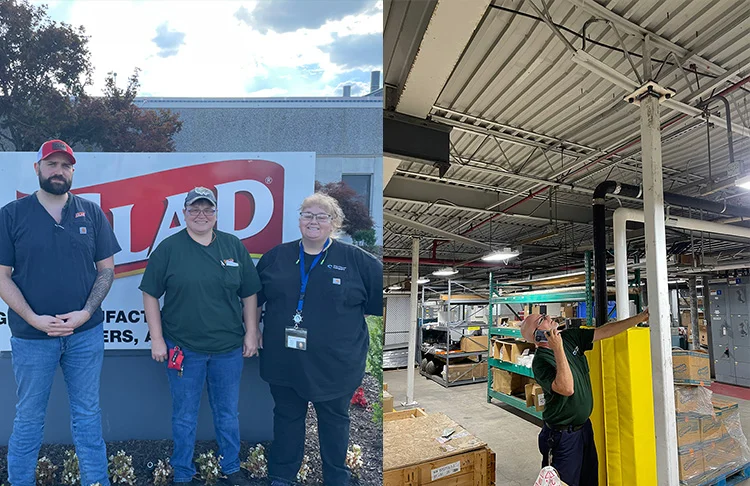Uniting to Restore Glad Plant Operations After Arkansas Tornado
The Clorox Company's Glad plant in Rogers, Arkansas, was hit by a tornado in late May, causing significant damage. Plant leaders and employees quickly responded to ensure safety and restore operations. Key actions included:
1. Evacuating over 100 employees to tornado shelters
2. Assessing and mitigating immediate risks (e.g., shutting off gas and electricity)
3. Cleaning up debris and water damage
4. Repairing the building structure
5. Restoring IT infrastructure
Despite challenging conditions, dedicated teams worked long hours to get the plant operational just two days after the tornado hit. The rapid response and collaborative effort demonstrated the resilience and commitment of Clorox employees in the face of adversity.
- Quick and effective emergency response ensured employee safety
- Plant resumed operations within two days of the tornado hit
- Employees showed dedication by voluntarily helping with cleanup and restoration
- Tornado caused significant damage to the Glad plant, potentially impacting production
- Extensive repairs and cleanup efforts required, likely incurring unexpected costs
NORTHAMPTON, MA / ACCESSWIRE / July 17, 2024 / The Clorox Company

By John McKay, Senior Director, Manufacturing - Glad and Brita
After several tornadoes hit Northwest Arkansas in late May, leaders at our Glad plant in Rogers were forced to spring into action to keep our people safe and then work to restore operations after the facility was hit directly by the storm.
For Aeryn Arrowsmith, team lead in extrusion, and the team, accountability for over 100 teammates was the primary concern. Five minutes after he got the tornado warning call, teammates started moving into the plant's two tornado shelters at 1:30 a.m. Eight minutes after they entered the shelters, the tornado hit, ripping cooling units off the roof and back doors, cutting the power and backup power. Water started leaking through the building, including into the two shelters.
Standing in about two inches of water, Aeryn, drawing from his military background, intuitively worked through next steps in his head - in a matter of seconds. He partnered with team leads Hollis Johnson and Dee Secrist to move teammates to dry areas of the building. He also shut down remaining electrical units that posed a major threat with the inbound water, cut the gas line due to a smell of natural gas in the air, shut off backup energy and walked through the plant to assess damage.
Once they took those steps, Aeryn and the leadership team sent all teammates home so they could be with their families and assess damage to their own homes. A few people remained at the plant to continue restoration operations. With no power or running water, the crew started cleaning the nearly two inches of standing water that occupied the building.
Over the next 36 hours, despite being told coming into work was optional, teammates showed up to help. But their work looked a little different than usual: They cleaned debris inside the building, pulled down ceiling tiles that had broken off because of the water pressure and removed anything that had water damage. The Facilities team documented damages and began implementing a recovery plan.
Paul Simpkins, a 33-year Glad veteran, was one of those facilities specialists who came in to assess and record the damage. Paul's day-to-day work involves ensuring the plant equipment, such as chillers, air dryers, ventilation system and HVAC systems, is running properly. So, when he got the call at 3:06 a.m. about the tornado damage, he knew the challenges ahead of him. In that first day, Paul took 88 phone calls -coordinating with roofing contractors and general contractors - to get emergency repairs done. By Sunday night,
As damage was being assessed and the plant was being cleaned, Charles "Skip" Nesbit, IT support lead, was in the server room with his team, working to ensure that the plant could function from a technical perspective. When the tornado hit, an EDT team, led by Karen Hancock and Heather Allen, was scheduled to be at the plant to upgrade all the tech systems. Due to extensive damage to the walls, roof and electrical cabinets, the team had to get everything cleaned and dried out before the power could be turned back on. While one EDT team focused on cleaning the plant, the other team worked on the tech infrastructure. Working 16-hour days for the two weeks following the tornado, the team got the plant up and running two days before their target date.
Paul, Aeryn and Skip all attribute their success to the dedicated team on the ground, which worked together to get the plant back up and running quickly. From the leadership team to the Facilities team to contractors to the EDT team and everyone in between, the teams worked in a "state of flow," as Paul put it, to get the job done. By Wednesday, two days after the tornado initially hit, the plant was operating safely.
View additional multimedia and more ESG storytelling from The Clorox Company on 3blmedia.com.
Contact Info:
Spokesperson: The Clorox Company
Website: https://www.3blmedia.com/profiles/clorox-company
Email: info@3blmedia.com
SOURCE: The Clorox Company
View the original press release on accesswire.com
FAQ
How did the tornado in May 2024 affect Clorox's (CLX) Glad plant in Rogers, Arkansas?
What measures did Clorox (CLX) take to ensure employee safety during the tornado at the Glad plant?
How long did it take for Clorox (CLX) to restore operations at the Glad plant after the May 2024 tornado?







